The first posthumous exhibition of Bangdel in London titled ‘Lain Singh Bangdel: Mountains and Migration’ was organised by Bonhams from 11th to 21st November 2023, which gave me a rare opportunity to look at a wide range of his works from different periods. In this essay, I discuss the psychology and politics of Bangdel’s art.
Bangdel lived through the pre-partition era of India and the artworks he produced during his formative period speak of his growing affiliation with the creative milieu of Bengal. In an unpublished essay from 1979, he quoted a popular saying from his times in Calcutta, – ‘What Bengal thinks today, India thinks tomorrow’. It only means that he did notice the city’s political awareness and valued it no less. He made his way to Europe just when India was building its independent national identity. Throughout his stay in Europe, his works continued to search for a Nepalese identity, firstly through ‘Muna Madan’ and later revisiting the central theme of mountains. Both of these need to be analysed before even trying to understand the politics of his art.
“With the ‘Abstract’ series, Bangdel attained his career-best, not only doubling the size of his canvas but also widening his artistic horizon.”
Mountains
Surrounded by Sikkim, Bhutan and Nepal, the Himalayan foothill of Darjeeling left a deep impression on Bangdel in his childhood. When he was twenty years old, life took him away from the mountains but they remained the central theme of his artworks for twenty-two-odd years until he eventually returned to Nepal. Serving as the refuge for his Nepalese identity, the theme of the mountains recurred in his works from the initial realistic watercolour ‘Himalaya’ (1955) to a semi-abstract ‘Moon Over Kathmandu’ (1962) and eventually a fully abstract ‘Abstract I & II’ (1969) and ‘Song of Himalaya’ (1973).
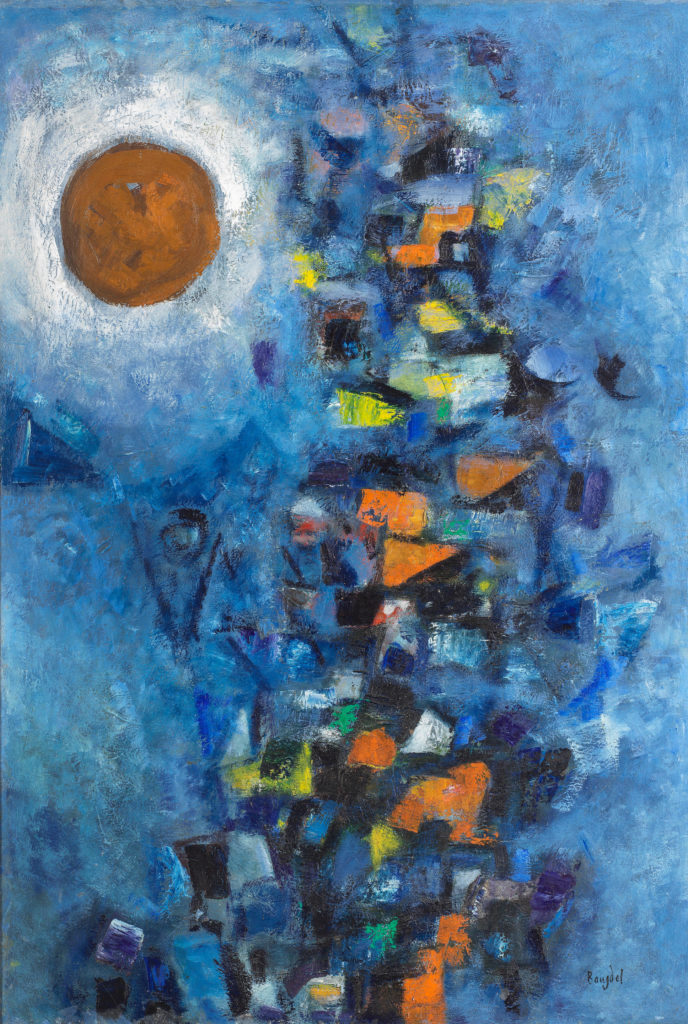
‘Moon Over Kathmandu’ was one of his first works on return to Nepal that paved the way for modern art in Nepal through a solo exhibition. However, it was not until he went to the USA for a Fulbright scholarship on Nepal’s art history that he gave the best out of his artistic genius. With the ‘Abstract’ series, Bangdel attained his career-best, not only doubling the size of his canvas but also widening his artistic horizon. What Beatriz Cifuentes Feliciano has called Bangdel’s aesthetic language referencing both Western trends and his local heritage, can be seen in full swing in some of these works. Starting from a more subtle palette involving various shades of brown, grey and olive, mountains fill in his subconscious through angular geometries that compose a cross-like stretch across the canvas.
The palette has then moved either to more figurative shapes and vivid colours along the same style or a greener rendition of the fertile soil of Kathmandu Valley. They looked more like variants than a complete branching off his newfound abstraction. While many of these were painted during his productive stay in Ohio, this very style also progressed to a more clustered and grid-like multicoloured montage like ‘My Childhood Valley’ (1971). The way he elaborated his ‘Abstract’ series during the 1970’s is also a great reminder of his consistent experimentation with art. In the same decade, much younger artists like Krishna Manandhar (SKIB-fame) also started experimenting with abstract landscapes. Still, Bangdel kept exploring non-figurative mountain themes which gave him his signature style.
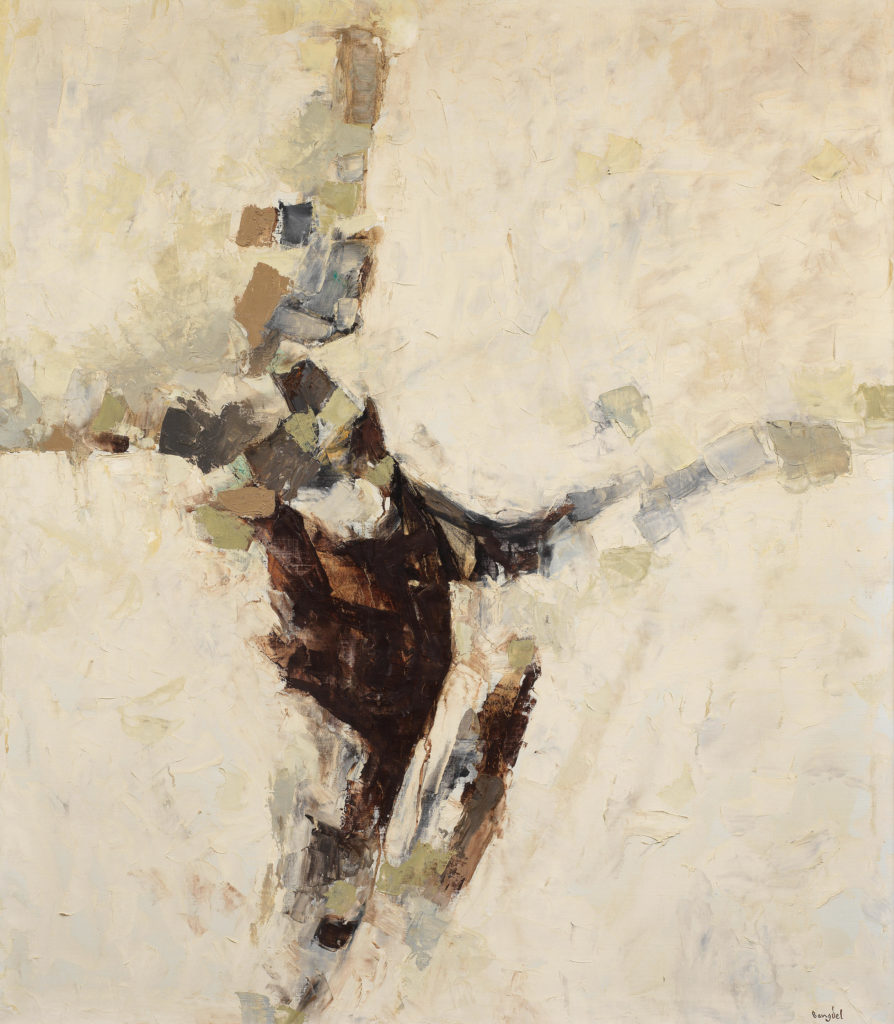
“The recurring terracotta-coloured Moon … represents his search for the Nepalese identity of Darjeeling where the Nepali literary movement was strong”
Migration
Art historians like Owen Duffy have earlier drawn similarities between Bangdel’s ‘Full Moon Night’ (1952) and ‘Moon Over Kathmandu’ (1962) owing to the unmissable shared features including the salmon-coloured Moon, abstract cityscape and reflections of the mountain terrains in the overall composition. Bangdel’s paintings have been discussed for their geometric abstraction that amalgamates two of his lifelong inspirations, – the city and the mountains. However, his artworks are yet to be analysed through the rare lens of a migrant’s homecoming and the psychological elements that thus form the basis of his artistic expression.
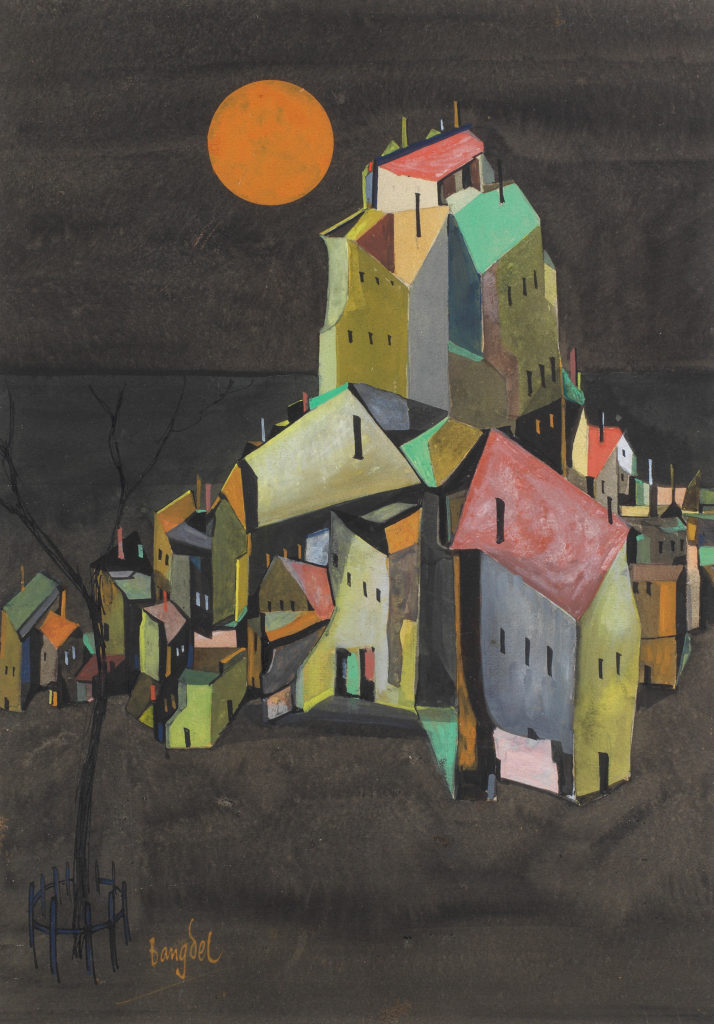
Bangdel’s abstraction of Kathmandu is not necessarily a purely lived reality but a juxtaposition of the Kathmandu he viewed half his life from outside Nepal, and the one he eventually arrived but after a major political change. ‘Moon Over Kathmandu’ hence represents the ultimate culmination of a long search for his own identity as a migrant and his playing a part in the systematic development of a new national identity for generations to come. While ‘Full Moon Night’ has a striking similarity with ‘Houses’ painted by Sayed Haider Raza in the same year, this theme was also visited a few years earlier by Jaqueline Lamba. Unlike in Raza’s work, the houses in Bangdel’s ‘Full Moon Night’ do not stand straight but are almost melting like Salvador Dali’s iconic clock from ‘The Persistence of Memory’ (1931). They are chaotically disoriented, and their ugliness resounds the views of the artist. A naked tree is silhouetted in the foreground which reveals an inherent sadness of loss and inadequacy. The tree is also tightly fenced leaving minimal area around it, which hints at the artist’s suffocation in a foreign land.
To me, the recurring terracotta-coloured Moon in both of the above works from Paris and Kathmandu represents his search for the Nepalese identity of Darjeeling where the Nepali literary movement was strong. In his 1969 interview with Eugene Register-guard, he referred to the sunset in Mt. Kanchenjunga as a long-lasting impression from his childhood, which must have been a shade of golden orange in colour. In a two-dimensional canvas, Bangdel’s moon is on one side of the abstract cityscape stretching from top to bottom, whereas he helplessly looks at it from the other side. Besides the main moon, there are other faded and smaller moons too, which could represent several other social identities he had become a part of while living in Calcutta, Paris, and London.
“Borrowing heavily from Picasso’s blue period, the characters have lyrical bodies with elongated limbs that stretch towards each other.
Muna Madan
While most Nepalese would be nearing a midlife crisis in their mid-30s, Bangdel was writing love poems from Paris to his wife Manu Thapa. Manu was a professional nurse in London who supported him financially. As an anagram of ‘Muna’ – the female protagonist in the love ballad, she embodied the melancholy of a long-distance relationship already immortalised in the all-time Nepali literary bestseller ‘Muna Madan’. Bangdel’s 1959 series ‘Muna Madan’, however, was more than just a visual narration of the celebrated literature. Borrowing heavily from Picasso’s blue period, the characters have lyrical bodies with elongated limbs that stretch towards each other. Standing tall across the height of the canvas, everything else is subdued by their inner grief while these figures invariably look down to the world around them. The colour gradually changes from bright and vivid to faded and dull, as the narration shifts from the couple’s union to a tragic separation.
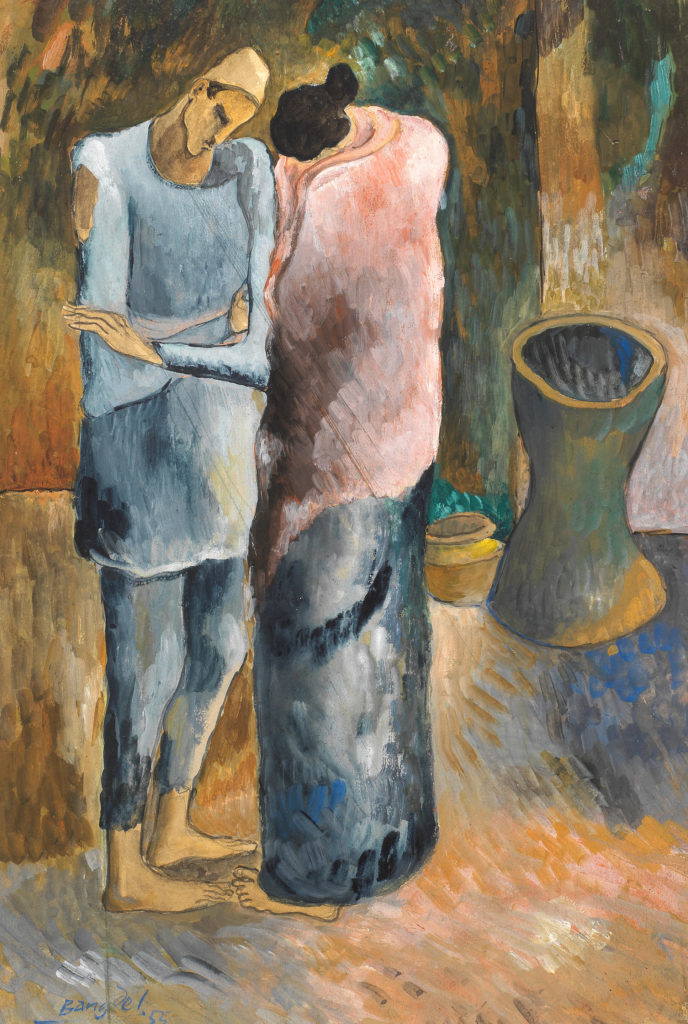
The series is also executed quite schematically in terms of the choice of backdrops. The lovers rejoice under an open sky with boundless pleasure. On the other hand, in ‘Muna Madan Departure Scene’, the pastel colour palette captures the emotional moment in all its softness and the suffocation inside the room is shared by an Okhal, a traditional Nepalese mortar. Known as Okhali in the local dialect, it is still preferred to modern grinder machines in most households of Darjeeling. Almost symbolically without its pestle, the same lonely mortar reappears next to a mourning Madan in the piece titled ‘Madan’s Agony’.
Unlike the more recent cover of the actual book where Tekbir Mukhiya has illustrated both Muna and Madan hugging each other, only Muna puts her hand around Madan in Bangdel’s version. Madan, who is leaving for Tibet to earn a living, consistently poses with his hands crossed which almost serves as a testament to Bangdel’s helplessness and longing for his supportive wife. Given that his country Nepal always formed the central theme throughout Bangdel’s breadth of work, one wonders if this series is also an outcome of something more than his personal love life, – the longing for a place he called his homeland but could only visit at an age of forty-two.
“the government was shaping how the liberal arts community should function and Bangdel was the chosen actuator.”
Politics
With dilapidated buildings and the presence of local dwellers, Bangdel’s formative watercolour titled ‘Suburbs of Calcutta’ (1943) is livelier than the sleeping city depicted in ‘Full Moon Night’. Interestingly, he did not choose one of the colonial buildings which perhaps presents him as a socialist just as most of his literary works do. It is hence important to research whether he was simply a ‘right man in the right place’ or his creativity was also critically engaged with the changing politics of the ’60s and the ’90s Nepal.
After banning the political parties in 1960, King Mahendra needed to establish a national identity which resonated with his idea of a new Nepal. In his agenda was also the modern art movement for which he invited Bangdel to Nepal. In a way, the government was shaping how the liberal arts community should function and Bangdel was the chosen actuator. One can hence argue whether Bangdel’s contribution to Nepalese modern art was out of his genuine feeling of the need for it and whether such an intervention could have been any better alternative for organic development. Bangdel believed that politics and art cannot go together. However, whether his career as an artist acted as a vehicle for a wider political movement is open to discussion.
It is hard to find any evidence either in Bangdel’s literary or artistic works if his idea of Nepalese identity leapt further in search of his ‘Rai’ ethnic identity. Darjeeling was a thriving as Nepali linguistic hub where authors like Paras Mani Pradhan and Indra Bahadur Rai were instrumental in standardising and further developing the Nepalese state-backed Nepali language. Whether he had any realisation of being an instrument to Nepal’s national identity building at the expense of cultural diversity is also not clear.
Bangdel was fond of the French art critic Andre Malraux. In the early 70s, Malraux was vocal about Bangladesh’s liberation war against the suppression of its Bengali speakers. This was a time when Bangdel had just completed his Fulbright scholarship on art history in the US, and it is quite unlikely that he would have completely disconnected himself from Marlaux’s opinions.
In the year 1991, Bangdel returned to an abstract and semi-abstract series of paintings with Democracy as their central theme. After two terms as Chancellor of the Royal Nepal Academy, Bangdel had retired a year before the 1990 People’s Movement for Democracy which makes it clear that he was not a part of the movement. As a spectator’s narrative, his visual montage of street protests adopted a figurative style. The eventfulness of his themes overwhelmed the depth of his artistic expression and not the other way around. We are hence left to ask if it was actually ‘felt by heart and soul’ which he once claimed as his process of abstraction. In this last leg of his artistic journey, the colours began to distance themselves from nature, brushstrokes disagreed with any visual coherence and the compositional legacy from his earlier success with abstraction was more technical than subconscious.
“… final phase of Bangdel’s creative output was a response to a certain sociopolitical climate but hardly a precursor to change.”
My major critique of this final phase of Bangdel’s creative output remains that it was a response to a certain sociopolitical climate but hardly a precursor to change. They might have worked as a reminder of the then-political influences but did not even aim at becoming the creative strength of the society to provoke its politics. This holds to date for the overall dismal achievement since the advent of modern art in Nepal while it still has a long way to go.
This story was originally published here.
Writes: Sanyukta Shrestha. He is an Art Historian associated with Art History Link-Up at the Courtauld Gallery in London.

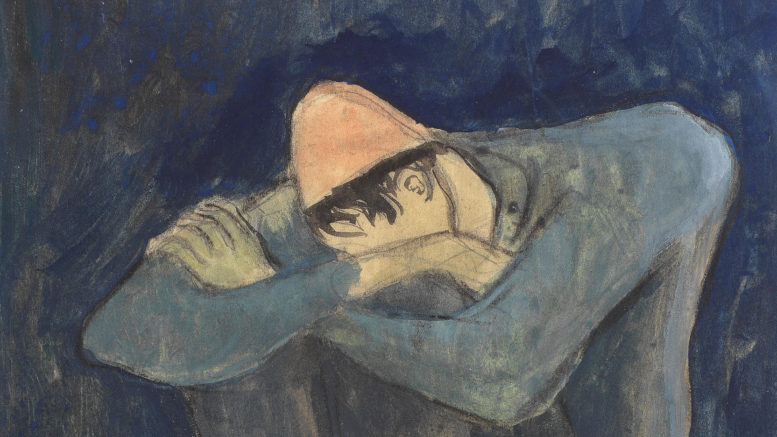
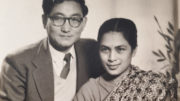
Be the first to comment on "The Psychology & Politics of Bangdel’s Art"